Next-gen gaming is already here. We've had a fully functional Xbox Series X on hand for a few days at this point, and although what we're running is technically a non-final build of the system, this is a real piece of next-gen hardware. The Velocity architecture, solid-state drives, AMD's Zen 2 CPU and RDNA 2 GPU outputting 12 TFLOPs--these are all things we've been constantly hearing about as we head into the Series X's November 10 launch. But now we have first-hand experience.
There are certain aspects of the Xbox Series X that we're not able to talk about quite yet, but of the things we can cover, we have general performance with backwards compatible Xbox One games, the hardware design itself, load times, and Quick Resume. And right now, I'm convinced that the latter two are the features that make next-gen gaming feel more advanced--it's those practical improvements that change the way we can play games and actually get more out of our time with them.
Here, we've tested exactly how much load times have improved in big games such as Red Dead Redemption 2 and Control when using the Series X compared to the Xbox One X--both off of internal storage drives. We also put Quick Resume into practice and saw how many game states it can suspend. But first, let's start with the gameplay experience itself.
Series X Boosted: Backwards Compatibility And General Performance
Currently, we don't have access to any Series X-specific content, but Microsoft has made a set of backwards compatible Xbox One games available, and is continually updating the library through this preview phase. In these first few days, I chose to play a variety games that are available through Game Pass, which consisted of the following:
- The Outer Worlds
- Final Fantasy XV
- Halo 5: Guardians
- Yakuza 0
- Yakuza Kiwami 2
- Nier: Automata
- Ori and the Will of the Wisps
- Monster Hunter World
- Bloodstained: Ritual of the Night
- State of Decay 2: Juggernaut Edition
These have all been smooth gameplay experiences, nothing too unexpected or drastically different from the Xbox One X in terms of performance so far, but I did want to call out one standout example of the Series X providing a noticeable boost. In Final Fantasy XV, I enabled "Lite" mode in the enhancement options, which is also available on the Xbox One X. This prioritizes framerate, allowing the game to run up to 60 FPS with a few graphical compromises. On the Xbox One X, the game would often drop below 60 FPS. With the Xbox Series X, from what I can tell, the game ran at a consistent 60 FPS the entire time.

Improvements in performance are on a case-by-case basis; keep in mind that my experience with FFXV is by virtue of the better hardware providing a boost and not a Series X-specific optimization.
From what we know so far, games that use dynamic resolution to keep smooth framerates will maintain higher resolutions, and possibly native 4K, by virtue of the console's power. Barring future performance updates from developers, some games (such as The Outer Worlds) are locked at 30 FPS, but at least you won't be dropping frames. And in games that allow higher framerates, such as FFXV with "Lite" performance mode enabled, you'll notice games consistently hitting that high mark with the Series X.
This may sound complicated, but there's nothing new on the user-end that's required other than simply starting up the game and playing, outside of choosing performance options when available (as we've seen with some cases of One X enhancements).
I've been using the LG BX series 4K HDR OLED TV with HDMI 2.1, which offers 120Hz refresh rate, meaning it can display up to 120 FPS. However, that feature has not been implemented in any content for this preview phase yet, although a few games such as Ori and the Will of the Wisps will get that 120 FPS enhancement at some point.

On the topic of backwards compatibility, you'll be happy to know that first-party games will support cross-gen multiplayer. I can confirm this from my time playing competitive matches in Halo 5 online using the Series X. For third-party games, it'll be up to the developers to enable cross-gen multiplayer (which has been confirmed for Call of Duty: Black Ops Cold War and a few others).
Short And Sweet Load Times
Now, for one of the heavy-hitting features of the Series X: short load times. Microsoft has been flexing its Velocity architecture and ultra-fast solid state drive, which allows the system to boast new features like Quick Resume, Direct Storage, and sampler feedback streaming. But it's the impressive I/O speeds that allow for a significant cut in load times in games--that's the practical application for players and I got to see that first-hand.
Simply put, the Xbox Series X loads games much, much faster than the Xbox One X, and we tested this out by recording load times on four different games. In going from the game's title screen to loading a save game to get to actual gameplay, we got the following numbers (with the help of my dear friend Jeff Bakalar, senior editor at CNET):
| Game | Xbox Series X Load Time | Xbox One X Load Time |
|---|---|---|
| Red Dead Redemption 2 | 38 seconds | 2 minutes, 8 seconds |
| Control | 10 seconds | 58 seconds |
| Final Fantasy XV | 13 seconds | 1 minute, 11 seconds |
| The Outer Worlds | 11 seconds | 43 seconds |
STAR WARS: Prequel Pack - Official Reveal Trailer DEAD OR ALIVE Xtreme Venus Vacation PRISM - Official 2nd Trailer Phantom Blade Zero - 6 Minute "Year of the Snake" Gameplay Trailer The Hundred Line -Last Defense Academy-: Character Trailer 1 GUILTY GEAR STRIVE: DUAL RULERS - Official Main Trailer Black Ops 6 & Warzone - Official Season 02 Launch Trailer Pokémon TCG Pocket: Space-Time Smackdown | Coming Soon! FINAL FANTASY VII REBIRTH - PC Launch Trailer over the hill - Announcement Trailer PAYDAY 3: Don't Be a Hero Trailer Vampires: Bloodlord Rising | Dragos Gameplay Trailer Kingdom Come: Deliverance 2 Roadmap Trailer
Please enter your date of birth to view this video
By clicking 'enter', you agree to GameSpot's
Terms of Use and Privacy Policy
These numbers indicate that the Xbox Series X cuts down on initial load times by 70-80% of the time it takes for the Xbox One X. This advantage extends to booting up games from the Xbox dashboard and also reloading saves. And the improvement we're seeing here is for existing games that weren't built with the tech in mind, but are simply taking advantage of the faster drive speeds. It's a snappy overall experience, similar to my PC with an NVMe SSD, which means you'll be spending less time waiting and more time gaming.
Quick Resume: The Literal Game-Changer
Related to the new tech and Velocity architecture: Quick Resume. It's the all-new Series X and Series S feature that lets you suspend the state of your current game to go into another one (and another one, and another one), all without shutting down or rebooting any of those games. In practice, Quick Resume works just by hitting the Xbox home button and switching over to a different game--there's no deliberate option or step you need to take to actually use the feature.
In conjunction with Game Pass, where I'm often jumping between multiple games I have downloaded anyway, Quick Resume truly shines.
I was able to keep six games simultaneously suspended in Quick Resume and hop between them to pick up right where I left off. When I booted a seventh game, the first game I queued up in the process (The Outer Worlds) had to be relaunched, so I lost the exact spot I had left it suspended in. There doesn't seem to be a warning when you're about to cause another game state to close completely, but let's be honest, having six games held in Quick Resume is more than enough. However, I do wish there was an indicator of how much you're pushing it.
Swapping between games takes about five to eight seconds, meaning you'll be right where you paused each game in a fraction of the time it would take to relaunch an entire game and without needing to reload a save. Game states even persist after powering the console off.

When it was first revealed, I didn't think much of Quick Resume until I experienced it for myself. Personally, I like jumping between different genres or styles of games when I sit down for a gaming session, mixing things up when I've had my fill. I'll get through pivotal story moments in an RPG and after a big boss fight, I'd go to something more chill for a while as a palette cleanser before hopping into a bunch of matches in a competitive shooter. So, in conjunction with Game Pass, where I'm often jumping between multiple games I have downloaded anyway, Quick Resume truly shines.
With Quick Resume, Xbox Series X showcases some genuinely innovative next-gen tech we don't even see on gaming PCs. It's kind of a game changer, literally.
The Xbox Series X Hardware
The new controller offers some subtle, but noticeable improvements over the current Xbox controllers. First is the textured grip on the handles, and to a lesser extent on the triggers and bumpers--this design choice provides a nice tactile feel that will help prevent slipping, especially for you sweaty folks out there. The dedicated share button is a much welcome feature too, letting you capture screenshots and video clips on the fly (which even works if you connect it to an Xbox One). The new 8-way directional pad is quite clicky and a bit stiff, though it is responsive. It's also quite different from the disc-like design of the Elite controller d-pad. I personally like the new design, but that really comes down to preference.
We all know that the Xbox Series X has that thick brick-like design, but it's not as big as you might think. It certainly towers over the other current-gen consoles in terms of height, whether you stand it up vertically or lay it sideways. Just make sure that you have enough space for that top vent (with the painted green styling), because that's where the main fan is pushing hot air out of the system. Either way, you'll want to make sure you have enough vertical clearance in your setup for it, but I don't find its size and shape all that prohibitive.

(You can get a much closer look at how the console stacks against other current-gen systems in our Xbox Series X and Series S size comparison feature.)
We're Impressed, But There's More To See
There's still a lot more to explore with the Xbox Series X, but that's most of what I can get into right now. Since we only have access to Xbox One backwards compatible games at the moment (without full Series X-specific optimizations), we haven't really had the chance to see the Series X fully flex its graphical horsepower quite yet. We're hoping to get that experience soon in the lead up to the console's launch.
For this phase of the preview period, I want to stress how refreshing it was to have such fast, snappy loading for console games, and to have Quick Resume changing the way I can jump from one game to another and get more out of my time playing. I've said this before, but I feel like next-gen console gaming will be greatly impacted by those practical improvements in the user experience more so than higher visual fidelity--and that's what I've been most impressed with in the Xbox Series X so far.

